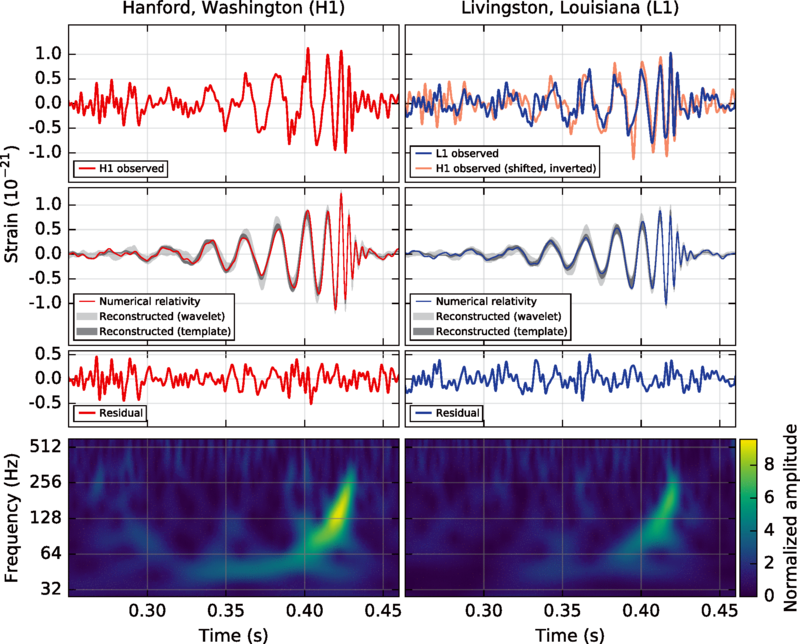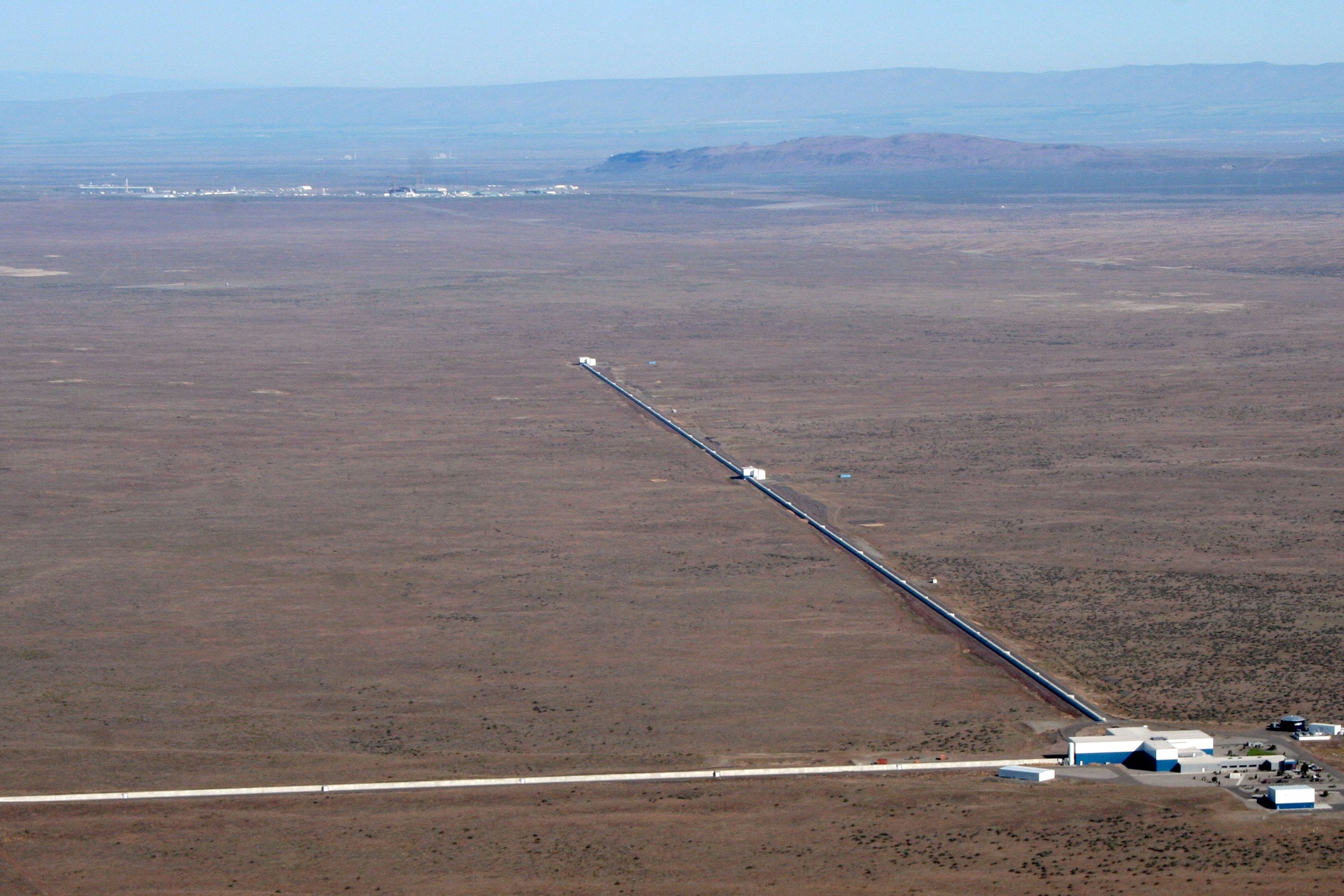|
Golden Binary
In gravitational wave astronomy, a golden binary is a binary black hole collision event whose inspiral and ringdown phases have been measured accurately enough to provide separate measurements of the initial and final black hole masses. Testing general relativity Current LIGO/Virgo protocol relies on its library of several hundred thousand precomputed templates of black hole collisions conceivably detectable in their frequency range. A putative binary black hole collision signal consists of inspiral, merger, and ringdown phases. The complete signal is compared with the template library, and event parameters and significance are based on an analysis of such matches. This allows for self-consistency checks of general relativity. In order to test certain competing theories of gravity, one faces the problem that only general relativity has been studied enough that the complete merger phase is known. Therefore, only a signal that can be matched separately in the inspiral and rin ... [...More Info...] [...Related Items...] OR: [Wikipedia] [Google] [Baidu] |
Gravitational Wave Astronomy
Gravitational-wave astronomy is a subfield of astronomy concerned with the detection and study of gravitational waves emitted by astrophysical sources. Gravitational waves are minute distortions or ripples in spacetime caused by the acceleration of massive objects. They are produced by cataclysmic events such as the merger of binary black holes, the coalescence of binary neutron stars, supernova explosions and processes including those of the early universe shortly after the Big Bang. Studying them offers a new way to observe the universe, providing valuable insights into the behavior of matter under extreme conditions. Similar to electromagnetic radiation (such as light wave, radio wave, infrared radiation and X-rays) which involves transport of energy via propagation of electromagnetic field fluctuations, gravitational radiation involves fluctuations of the relatively weaker gravitational field. The existence of gravitational waves was first suggested by Oliver Heaviside in 18 ... [...More Info...] [...Related Items...] OR: [Wikipedia] [Google] [Baidu] |
Binary Black Hole
A binary black hole (BBH), or black hole binary, is an astronomical object consisting of two black holes in close orbit around each other. Like black holes themselves, binary black holes are often divided into binary stellar black holes, formed either as remnants of high-mass binary star systems or by stellar dynamics, dynamic processes and mutual capture; and binary supermassive black holes, believed to be a result of galactic mergers. For many years, proving the existence of binary black holes was made difficult because of the nature of black holes themselves and the limited means of detection available. However, in the event that a pair of black holes were to merge, an immense amount of energy should be given off as gravitational waves, with distinctive waveforms that can be calculated using general relativity. Therefore, during the late 20th and early 21st century, binary black holes became of great interest scientifically as a potential source of such waves and a means by whi ... [...More Info...] [...Related Items...] OR: [Wikipedia] [Google] [Baidu] |
LIGO
The Laser Interferometer Gravitational-Wave Observatory (LIGO) is a large-scale physics experiment and observatory designed to detect cosmic gravitational waves and to develop gravitational-wave observations as an astronomical tool. Prior to LIGO, all data about the universe has come in the form of light and other forms of electromagnetic radiation, from limited direct exploration on relatively nearby Solar System objects such as the Moon, Mars, Venus, Jupiter and their moons, asteroids etc, and from high energy cosmic particles. Initially, two large observatories were built in the United States with the aim of detecting gravitational waves by laser interferometry. Two additional, smaller gravity wave observatories are now operational in Japan KAGRA, (KAGRA) and Italy Virgo interferometer, (Virgo). The two LIGO observatories use mirrors spaced four kilometers apart to measure changes in length—over an effective span of 1120 km—of less than one ten-thousandth the charge radius, ... [...More Info...] [...Related Items...] OR: [Wikipedia] [Google] [Baidu] |
Virgo Interferometer
The Virgo interferometer is a large-scale scientific instrument near Pisa, Italy, for detecting gravitational waves. The detector is a Michelson interferometer, which can detect the minuscule length variations in its two arms induced by the passage of gravitational waves. The required precision is achieved using many systems to isolate it from the outside world, including keeping its mirrors and instrumentation in an ultra-high vacuum and suspending them using complex systems of Pendulum, pendula. Between its periodic observations, the detector is upgraded to increase its sensitivity. The observation runs are performed in collaboration with other similar detectors, including the two Laser Interferometer Gravitational-Wave Observatories (LIGO) in the United States and the Japanese Kamioka Gravitational Wave Detector (KAGRA), because cooperation between several detectors is crucial for detecting gravitational waves and pinpointing their origin. Virgo was conceived and built whe ... [...More Info...] [...Related Items...] OR: [Wikipedia] [Google] [Baidu] |
General Relativity
General relativity, also known as the general theory of relativity, and as Einstein's theory of gravity, is the differential geometry, geometric theory of gravitation published by Albert Einstein in 1915 and is the current description of gravitation in modern physics. General theory of relativity, relativity generalizes special relativity and refines Newton's law of universal gravitation, providing a unified description of gravity as a geometric property of space and time in physics, time, or four-dimensional spacetime. In particular, the ''curvature of spacetime'' is directly related to the energy and momentum of whatever is present, including matter and radiation. The relation is specified by the Einstein field equations, a system of second-order partial differential equations. Newton's law of universal gravitation, which describes gravity in classical mechanics, can be seen as a prediction of general relativity for the almost flat spacetime geometry around stationary mass ... [...More Info...] [...Related Items...] OR: [Wikipedia] [Google] [Baidu] |
Alternatives To General Relativity
Alternatives to general relativity are physical theories that attempt to describe the phenomenon of gravitation in competition with Einstein's theory of general relativity. There have been many different attempts at constructing an ideal theory of gravity. These attempts can be split into four broad categories based on their scope: # Classical theories of gravity, which do not involve quantum mechanics or force unification. # Theories using the principles of quantum mechanics resulting in quantized gravity. # Theories which attempt to explain gravity and other forces at the same time; these are known as classical unified field theories. # Theories which attempt to both put gravity in quantum mechanical terms and unify forces; these are called theories of everything. None of these alternatives to general relativity have gained wide acceptance. General relativity has withstood many tests over a large range of mass and size scales. When applied to interpret astronomical observat ... [...More Info...] [...Related Items...] OR: [Wikipedia] [Google] [Baidu] |
GW150914
The first direct observation of gravitational waves was made on 14 September 2015 and was announced by the LIGO and Virgo collaborations on 11 February 2016. Previously, gravitational waves had been inferred only indirectly, via their effect on the timing of pulsars in binary star systems. The waveform, detected by both LIGO observatories, matched the predictions of general relativity for a gravitational wave emanating from the inward spiral and merger of two black holes (of 36 and 29 ) and the subsequent ringdown of a single, 62 black hole remnant. The signal was named GW150914 (from ''gravitational wave'' and the date of observation 2015-09-14). It was also the first observation of a binary black hole merger, demonstrating both the existence of binary stellar-mass black hole systems and the fact that such mergers could occur within the current age of the universe. This first direct observation was reported around the world as a remarkable accomplishment for many re ... [...More Info...] [...Related Items...] OR: [Wikipedia] [Google] [Baidu] |
GW151226
GW151226 was a gravitational wave signal detected by the LIGO observatory on 25 December 2015 local time (26 Dec 2015 UTC). On 15 June 2016, the LIGO and Virgo collaborations announced that they had verified the signal, making it the second such signal confirmed, after GW150914, which had been announced four months earlier the same year, and the third gravitational wave signal detected. Event detection The signal was detected by LIGO at 03:38:53 UTC, with the Hanford detector picking it up 1.1 milliseconds after the Livingston detector (since the axis between the two was not parallel to the wave front); it was identified by a low-latency search within 70s of its arrival at the detectors. Astrophysical origin Analysis indicated the signal resulted from the coalescence of two black holes with and times the mass of the Sun, at a distance of megaparsecs (1.4 billion light years) from Earth. The resulting merged black hole had solar masses, one solar mass having been radiated aw ... [...More Info...] [...Related Items...] OR: [Wikipedia] [Google] [Baidu] |
Black Holes
A black hole is a massive, compact astronomical object so dense that its gravity prevents anything from escaping, even light. Albert Einstein's theory of general relativity predicts that a sufficiently compact mass will form a black hole. The boundary of no escape is called the event horizon. A black hole has a great effect on the fate and circumstances of an object crossing it, but has no locally detectable features according to general relativity. In many ways, a black hole acts like an ideal black body, as it reflects no light. Quantum field theory in curved spacetime predicts that event horizons emit Hawking radiation, with the same spectrum as a black body of a temperature inversely proportional to its mass. This temperature is of the order of billionths of a kelvin for stellar black holes, making it essentially impossible to observe directly. Objects whose gravitational fields are too strong for light to escape were first considered in the 18th century by John ... [...More Info...] [...Related Items...] OR: [Wikipedia] [Google] [Baidu] |
Gravitational-wave Astronomy
Gravitational-wave astronomy is a subfield of astronomy concerned with the detection and study of gravitational waves emitted by astrophysical sources. Gravitational waves are minute distortions or ripples in spacetime caused by the acceleration of massive objects. They are produced by cataclysmic events such as the merger of binary black holes, the coalescence of binary neutron stars, supernova explosions and processes including those of the early universe shortly after the Big Bang. Studying them offers a new way to observe the universe, providing valuable insights into the behavior of matter under extreme conditions. Similar to electromagnetic radiation (such as light wave, radio wave, infrared radiation and X-rays) which involves transport of energy via propagation of electromagnetic field fluctuations, gravitational radiation involves fluctuations of the relatively weaker gravitational field. The existence of gravitational waves was first suggested by Oliver Heaviside in 1 ... [...More Info...] [...Related Items...] OR: [Wikipedia] [Google] [Baidu] |


